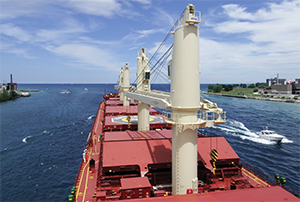“Sécurité, sécurité, sécurité, saltwater vessel Isolda to depart Andersons K in 20 minutes,” announced George Haynes, a pilot with the Lakes Pilots Association. It was 1228 and, VHF in hand, he stood near the helm of Isolda, a 656-foot Polsteam bulk carrier that had just sealed the hatches over 22,000 metric tons of corn bound for Porto, Portugal, from elevators along the Maumee River at Andersons Grain & Ethanol in Toledo, Ohio. Lakes Pilot trainee Sean Liljegren observed. Liljegren has already been cleared to pilot vessels in and out of Cleveland, which is considered a medium-difficulty port.
Toledo is a different story. Lake Erie lies only six miles down the Maumee from Andersons K, but Lakes Pilots District 2 considers this waterway, known as “the elevators,” as the hardest job in the district. “It’s the final test for a trainee,” Haynes said. Liljegren, a 2010 Great Lakes Maritime Academy graduate with four years of experience as mate on Interlake Steamship Company vessels, joined the Lakes Pilots in May 2015, his piloting skills rapidly propelling him toward becoming a federally registered pilot.
On the drive from the pilots’ office in Port Huron, Mich., to Toledo, Haynes enumerated his concerns about this job, with its six bridges to negotiate. “One is a very busy and narrow railroad bridge, two are bascule bridges, and one — the Anthony Wayne Bridge — is quite low, built when lake ships were much smaller,” he said. The narrow swivel rail bridge, referred to as Norfolk Southern South and located on a bend in the river, has a horizontal clearance of only 107 feet. Amtrak trains cross the bridge at reduced speeds because the passenger terminal is nearby, and freight trains sometimes stop across the swivel span for crew change, no matter what vessel might seek passage.
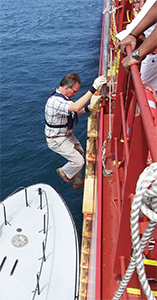 |
|
With his work aboard finished, pilot George Haynes descends from the ship to board Huron Belle. |
Thunderstorms had crossed the Toledo area the night before, delaying cargo loading and departure time by about six hours, so Haynes also monitored the current meter and water level. “If there’s anything greater than 0.9 knots, the tugs refuse to assist ships there,” he said. At the moment Isolda prepared to head outbound, the current flowed upstream past the Anderson elevators, an outcome of what southwesterly storm winds set in motion on Lake Erie, blowing water out of Toledo and piling it up in Buffalo until it surged back, causing the upstream current.
Arriving shipside an hour earlier, Haynes took his time studying the ship’s draft markings and the current. “The Maumee looks like a muddy, lazy river,” he said, “but with its multiple challenges, I don’t like to be hurried.” In addition to the bridges, factors like current, water level and weather can complicate a ship move. At that moment, the wind was increasing.
By noon Haynes and Liljegren were on board, had met the ship’s bridge crew to discuss technical details of the freighter’s propulsion, and had spoken with the tug captains of Great Lakes Towing’s Nebraska and Mississippi to devise a plan. “For safety reasons, we always use two tugs here,” said Haynes, a 20-year member of the Lakes Pilots Association. “You never know when a bridge might fail to open or wind could shift. Holding position in a crosswind is not pretty, even if it’s all mud along the banks.”
The original plan of the day scheduled the integrated tug-barge Victory/James L. Kuber on the other side of the river to go first, but the captain of the ITB — which was too long to turn around and had to depart stern first — suggested that Isolda take the lead. Rick Smith, captain of Nebraska, communicated with the swivel bridge tender, one of several conversations monitored simultaneously by Haynes.
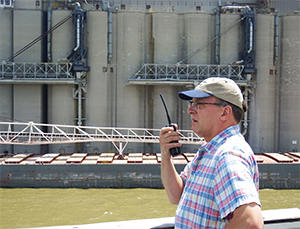 |
|
Haynes coordinates the efforts of multiple crews guiding the bulk carrier Isolda out of “the elevators” on Ohio’s Maumee River. |
After the security call, Haynes called for longshoremen and Isolda’s crew to let go all lines forward and all but the spring line aft. While Isolda chief officer Marian Labanowski relayed that command to his crew in Polish, Haynes called for “full thrust to starboard,” which the Isolda helmsman called back as understood and executed. Seconds later that was changed to “stop thrust.”
By 1245, Haynes had called for Mississippi to slacken its towline. Standing on the starboard bridge wing, he called out a series of commands to the Isolda helmsman. No other conversation took place as the loaded freighter moved slowly through the opening, leaving no more than 15 feet on either side of the vessel.
A half-mile beyond Norfolk Southern South was the Anthony Wayne Bridge, lower than the lowest bridge over the Welland Canal. “A pilot needs to ensure that any vessel coming through the Anthony Wayne Bridge will clear,” Haynes said. “We need to check water level and mast height. If a mast is too high and collapsible, it’s lowered. If it’s too high and fixed, it’s cut off. With newer ships, we check blueprints. Older ships have sometimes been altered, and if we don’t trust the clearance, we need to physically measure it.”
Isolda’s mast was still folded down from its inbound passage. As the ship slid clear, Haynes was already watching for the double-leaf bascule King Bridge, a mile ahead, to start opening.
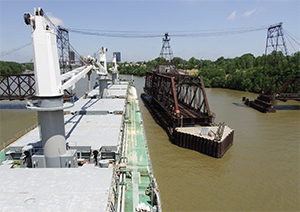 |
|
Isolda traverses the narrow Norfolk Southern South swivel bridge. |
By 1305, as Isolda approached the King Bridge, Haynes was already arranging with the ship’s crew to prepare the pilot’s ladder for the starboard side. Liljegren would assume pilotage for the remaining three bridges over the Maumee while Haynes observed. Then Liljegren would pilot Isolda across Lake Erie to Port Colborne, about 16 hours away, before handing the ship over to a Canadian pilot for passage through the Welland Canal.
Rules established by the Great Lakes Pilotage Act of 1960 — the year after the opening of the St. Lawrence Seaway — stipulate that all non-U.S. and non-Canadian vessels conducting commercial activities on the lakes must take U.S. or Canadian registered pilots. U.S. and Canadian domestic vessels are exempt because all Great Lakes vessel officers from third mate to captain are required to have a first-class pilot endorsement on their Coast Guard license. “All graduates from Great Lakes Maritime Academy have earned that endorsement before they graduate,” Haynes said.
Each trip is different for a pilot. Two days after the Isolda job, Haynes drove from Port Huron to Detroit to board the upbound bulk carrier Federal Churchill at the J.W. Westcott dock just downstream from the Ambassador Bridge. But even before boarding the pilot boat Huron Maid, a phone call from trainee pilot Ralph Kinsley, whom Haynes would relieve, triggered a flurry of follow-up calls. Kinsley reported that organizers of the Port Huron-to-Mackinac boat race had closed the St. Clair River at Port Huron from 1000 until 1800, a closure that would delay not only Federal Churchill but also nearly a dozen other upbound and downbound cargo ships. In less than 10 minutes, Haynes had spoken with race organizers, the Canadian Coast Guard and U.S. Coast Guard — calls that confirmed there was confusion about that day’s bureaucratic obstacles to commercial navigation at the south end of Lake Huron.
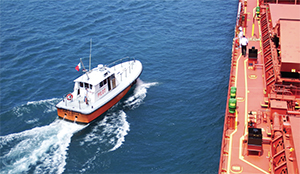 |
|
Huron Belle approaches Federal Churchill to switch pilots. Belle and Huron Maid will be joined this year by a third transport, Huron Spirit, to serve the Lakes Pilots Association. |
By 0800, Haynes had traveled out on Huron Maid and climbed aboard the bulker, about 30 feet up the ladder. Federal Churchill, Majuro-flagged and launched only a few months earlier in Japan, was traveling in ballast to load wheat in Duluth, Minn., for Algeria. While setting up his laptop computer on the bridge, Haynes conferred with Kinsley, who had piloted the ship during the 18-hour trip across Lake Erie from Port Colborne, on matters including sea speed, drafts forward and aft, compass deviation and relevant traffic.
After Kinsley departed on Huron Maid, Haynes’ calls to the helmsman about compass heading and speed alternated with follow-up communication to gain assurances that commercial traffic would flow unimpeded by the sailing race soon to start out in Port Huron, six or seven hours upbound. Meanwhile, Haynes and the crewman he requested be stationed at the bow scanned the shipping channel ahead, the summer Saturday morning having attracted all manner of small boats from fishermen anchored in the channel to kayaks and even a stand-up paddler who seemed about to misjudge Federal Churchill’s speed and cross in front of its bow.
Haynes never relaxed much during the run from Detroit into Lake Huron, where he would turn over pilotage to a District 3 lakes pilot, who would likely stay with the ship until Duluth. He interspersed course-change calls like “port 10, port five, midships, 048 degrees, 046 degrees” with more follow-up communication on the Port Huron river closure. As Federal Churchill approached the St. Clair Power Plant in East China, Mich., he called for “check down,” a slower speed to avoid disturbing the self-unloading gear discharging coal from the 1,000-footer American Integrity.
The 14 pilots currently working in District 2 operate with six company cars, deemed the most cost-effective way to position pilots where needed in ports ranging from Buffalo to Port Huron. In addition, the organization has four employees to staff their pilot boats 24/7 — Huron Maid and Huron Belle, which entered service in 1976 and 1979, respectively, and which deliver and retrieve Canadian as well as U.S. pilots. District 2 will take delivery of a new pilot boat, Huron Spirit, from Gladding-Hearn Shipbuilding later this year.
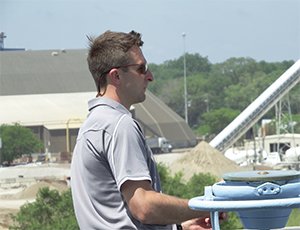 |
|
Lakes Pilots trainee Sean Liljegren assists an outbound ship at “the elevators” in Toledo. The Maumee River passage is considered the most difficult one in the district |
Contrary to what some think, the Lakes Pilots Association is not a union. Pilots pay no dues. The association is a business with fixed costs paid to support buildings, cars, employees, insurance, loans and minimum pay to pilots. According to Haynes, “The minimum is just that and most pilots would not stay here very long if we made minimum every year.” There are also variable costs that fluctuate with the amount of business. After all of that is covered, what’s left over is pilot compensation.
In 2016, the Coast Guard raised rates but in previous years has lowered them. According to Dan Gallagher, president of Lakes Pilots District 2, the USCG determined that a decade of underfunded pilotage had led to delays for commercial vessels because of a shortage of pilots, resulting in excessive workloads, inadequate rest and insufficient training. However, a coalition including shipping companies from Canada and Europe, along with U.S. industry lobbying groups, recently sued the Coast Guard over the increased rates.
By 1330, Federal Churchill was approaching Port Huron. Although the waterway was declared open, recreational craft congested the channel. Some small-boat operators appeared to have little sense of the danger a large bulk carrier posed to them, invisible to the ship’s bridge as they zigzagged within only a few dozen yards of the bow. Haynes sounded the danger signal repeatedly. As the ship safely cleared the Blue Water Bridge and headed into Lake Huron, Huron Belle came alongside and John Olney, a District 3 pilot, climbed the pilot ladder and four decks to the bridge to begin the handoff with Haynes, who would soon descend to Huron Belle. After having safely and efficiently piloted another foreign-flagged bulker through the waters between Lake Erie and Lake Huron on this race day, he was off to the pilots’ station, where he might face other matters.

